Feel good your way: Insight summary 1 - Young people's lives
Feel good your way
Contents
- Introduction
- What matters to young people
- Influencers on young people
- The role of physical activity in young people’s lives
- Young people as digital natives
- Impact of the pandemic and cost of living crisis
- Implications for Feel Good Your Way
- References
1. Introduction
The purpose of this summary is to draw on existing research since 2017 and create a broad insight into the lives of young people. Whilst this is not a systematic review, it offers a broad picture of young people’s current experiences.
Where available evidence allows, we focus particularly on our audience of interest of girls aged 11-15 in Greater Manchester.
The insight from this summary, along with that from our other summaries in this series, engagement with stakeholders, and direct engagement with young people, will inform the creative brief for the Greater Manchester Moving campaign.
Greater Manchester is home to 898,000 children and young people under the age of 25 and this number is growing. Children growing up in Greater Manchester are from diverse backgrounds and communities, and face some of the biggest challenges.
Compared to the UK average we know that:
- Children growing up in Greater Manchester have a lower life expectancy than the national average.
- More children in Greater Manchester live in poverty.
- Children have worse health outcomes including more children with obesity and more children with asthma.
- More children are in the looked-after system, a number that is increasing.
- Despite improvements in recent years, a third of Greater Manchester children start school not ready to learn.
- According to the Greater Manchester Poverty Action Group (GMPA, 2021) there are 145,000 children in Greater Manchester living in relative poverty, with significant inequalities across the region.
Young people in Greater Manchester live rich and complex lives and are experiencing more influences and pressures than any generation before. Within that overall cohort, age 11-15 is identified as a particularly crucial stage in young people’s development, when they begin moving from child to adult and start to exert greater independence.
A report from Street Games (2016) identified three key stages which adolescents move through as they become young adults.
- Initially they are still their child self (up to around age 14); Taking Part in a way which is more influenced and managed by external forces such as parents and teachers.
- They next become an adolescent self (up to around age 18), where life becomes more serious, exams become a feature, and Fitting In with peers is very much the priority.
- They then become their young adult self, where they are Gaining Control, taking full responsibility for themselves, their money and their future.

As with previous generations, there is pressure to have the right brands and be part of the right groups; however, social media in particular creates a culture of always on and needing to be seen, which can cause feelings of anxiety, depression and isolation for many teenagers.
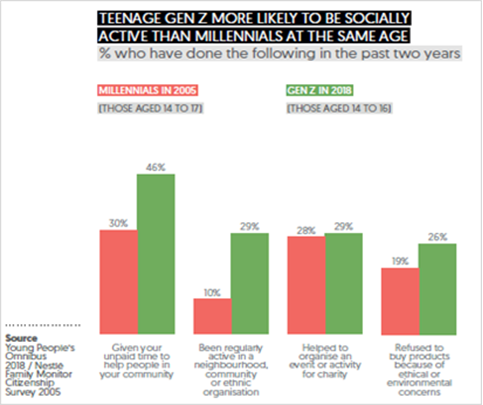
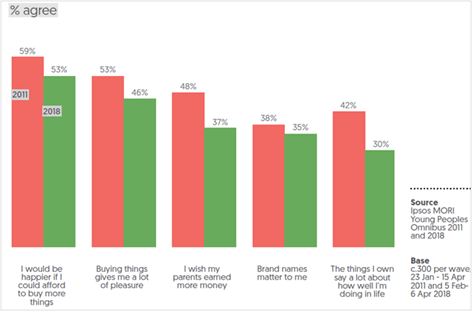
The need to fit in and gain peer approval is powerful.
2. What Matters to Young People
Ipsos MORI’s Beyond Binary report (2018) highlighted a number of interesting insights about what is important to young people in the UK today.
- Conscientious Shoppers: A quarter of British teenagers say they have avoided certain products because of the conditions under which they were produced or what they are made from (c.f. 19% Millennials at the same age).
- Materialism: Just 30% of teenagers in 2018 (11-17) felt the things they own say a lot about how well they are doing in life (c.f. 42% in 2011).
- Climate conscious: 62% UK school leavers (age 15-16) are worried about climate change; but many are confused about the causes (Ipsos MORI, 2022).
Young people aged 11-16 report a range of priorities (YST, 2021), including 52% of 5-16-year-olds seeing ‘being healthy’ as a priority (up from 45% in 2014). 41% 11-16-year-olds also said they worried about the health of their family (up from 23% in 2014 and undoubtedly driven by the pandemic).
Health is also reflected in young people’s main worries, with the same report finding 69% 11-16-year-olds were worried about viruses and diseases.
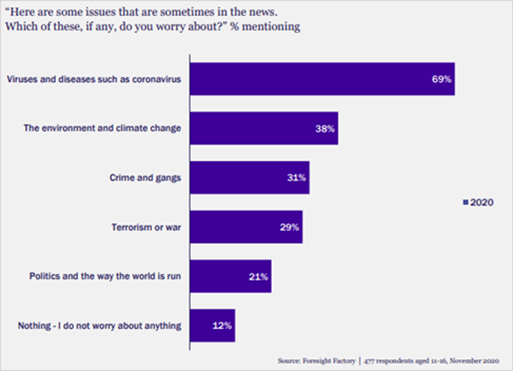
A study by Ipsos MORI (2020) found that diversity of sexuality and related attitudes have become more diverse with each generation. Gen Z (born 1997-2012) are much more sexually diverse than the general population (Fig. 2). 48% of Gen Z are familiar with terms such as pansexual, omnisexual and asexual, compared with 1 in 5 Britons (19%) overall.
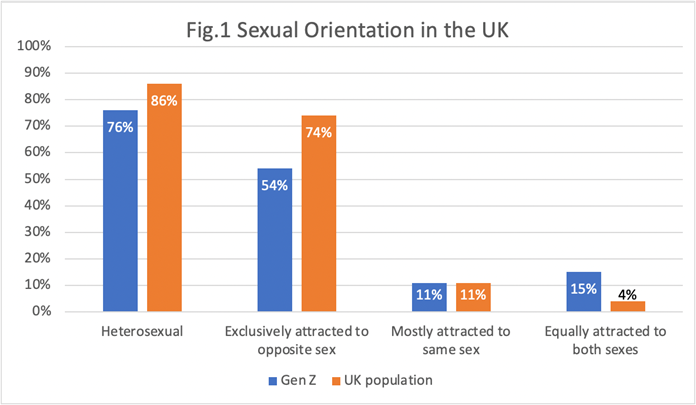
Girls are also more likely to worry about how they looked or what others think. 50% girls (c.f. 33% boys) said they felt under pressure to look good, whilst 26% girls (c.f. 16% boys) said they worry what people write on social media. Although interestingly, there was a greater increase in boys worried about looking good since 2014 (24%), suggesting appearance is a growing area of concern for boys too.
Alongside this, the young people in our age group face increasing pressure in school, with 52% 11-16-year-olds saying they are worried about how well they are doing in school.
For teenage girls, a report from Women in Sport (2019) identified 5 key anchors that were important in their lives.

The report also identified that, in addition to those girls who see themselves as ‘sporty’ or ‘not sporty’, there is a significant cohort who class themselves as ‘used to be sporty’. Many of these girls used to enjoy PE at primary school, but feel it has become more serious and less fun on transitioning to secondary PE. They have limited experience being active in other ways outside of this environment and so effectively ‘rule themselves out’ of being active in the future.
For many girls who are ‘not sporty’ or ‘used to be sporty’ in particular, they face emotional and psychological barriers, such as not feeling good enough to take part, lack of body confidence, a feeling that they do not belong in sport, and anxiety about meeting new people face to face.
3. Influencers for Young People
Women In Sport (2019) highlighted that, despite growing independence, a girl’s family is still an important source of support, advice and influence during their teenage years. Familial relationships are real and authentic and less likely to be played out online. This is important, as the family unit is where girls feel most free to express themselves without fear of judgement.
Mothers hold significant importance, with many girls reporting their mum as their top role model, and ‘Mum and daughter time’ emerging as something girls cherish.
According to research from Women in Sport (2022), parents can be one of the most important sources of support and encouragement to be active for both teenage boys and girls (11-18). However, they also found that, whilst mums support boys and girls equally, dads are much less likely to support their daughters.
Women In Sport (2019) also identified that friends are increasingly important as girls move into secondary school, becoming a vital source of emotional support as well as powerful influencers of behaviour, as girls strive for a sense of belonging beyond their immediate family.
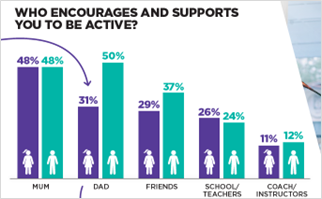
However, they can also be a negative force, as girls become increasingly competitive and judgemental of one another. School PE or sports activities are often prime breeding grounds for gossip and shaming between girls. Increasingly, friendships are also played out and maintained on social media, with peer-to-peer pressure adding to a sense for many girls that friendships are stressful to manage.
A report from Activity Alliance (2020) suggested that disabled children and young people are much more reliant on their parents, and 20% saw sport and physical activity as a way to grow their independence.
The report also demonstrated that disabled children and young people were more likely to be active if their parents were also active.
4. The Role of Physical Activity in Young People’s Lives
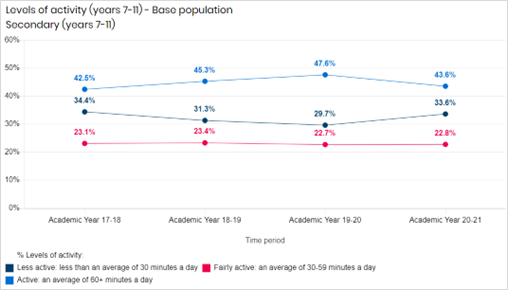
UK Chief Medical Officer’s guidance (DHSC, 2019) tells us that young people, aged 5-18, should engage in moderate to vigorous physical activity for at least 60 minutes per day in order to access the full range of health benefits, including mental health benefits, that it can provide.
Young People’s Overall Activity Levels remain stubbornly low
Data from Sport England’s Active Lives Survey (2021) shows us, however, that nationally, less than half of young people of secondary school age are achieving this, with a third participating less than 30 minutes a day.
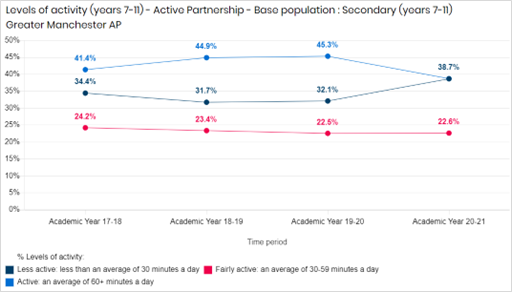
This trend is mirrored within Greater Manchester, where in fact the levels of less active young people at this age are even higher.
Girls’ activity levels on the rise
If we look nationally by gender, we can see that, for girls, numbers who are less active have slightly fallen in recent years. Interestingly there has been a parallel increase in the number of less active boys in the last 12 months as pandemic restrictions have been lifted.
A deep dive into Active Lives data earlier this year (Press Red, 2022) found that:
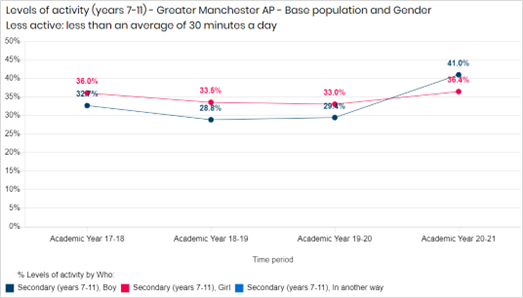
- Activity levels for girls (age 5-16) has risen by 2.4%.
- The biggest rise among girls has been from year 9-11 (age 13-16) – up 5.6%.
- The biggest rise among year 9-11 girls has been among those from higher affluence families and white backgrounds.
- The increase has occurred even though participation in sporting activities has declined. This has been compensated for by a dramatic rise in walking for both leisure and travel, and to a smaller extent dance.
- The rise is not purely linked to covid-related activities as the increase had begun in the 2017/18 academic year, before the pandemic hit.
Notably, however, in Greater Manchester, whilst an increase in the numbers of girls achieving 60 minutes a day has been mirrored, this has stemmed from those who were Fairly Active moving to be Active. The number of secondary age girls who are less active in Greater Manchester has remained essentially flat.
Research with young people and parents in Greater Manchester (Britain Thinks 2019) found that:
- There tends to be especially low awareness of the Chief Medical Officer (CMO) guidelines for children, and that these seem unrealistically demanding for older children (16+).
- Short-term benefits of activity – improved sleep, improved mood, quality time with family, physical appearance – are especially motivating, while long-term health risks feel particularly remote and less relevant.
- The largest barriers for this audience are physical activity having to compete directly with ‘more fun’ activities; peer influences; lack of time (both of young people & parents); and reliance on parents to access facilities
The proportion of young people (11-16) in the UK who claim that they want to do more sport and exercise has grown from 44% in 2014, to 54% by 2020 (YST, 2021). Data from Active Lives (Sport England, 2021) shows that almost all secondary age children in Greater Manchester recognise that being active is good for them.
The majority also say they enjoy being active, although notably, boys are more likely to strongly agree that they enjoy being active, whilst girls are more likely to disagree with this statement. Girls in Greater Manchester are also more likely to disagree that they feel confident taking part.
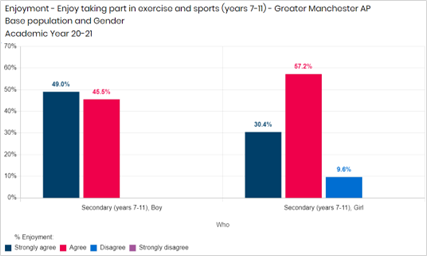
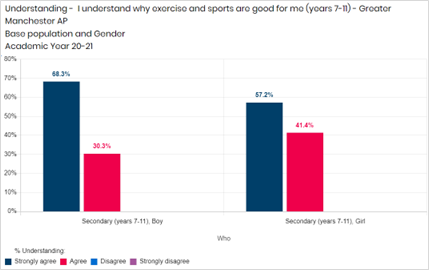
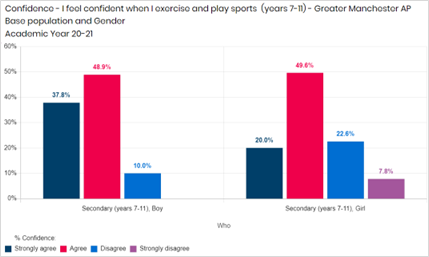
Looking at girls specifically, the award-winning This Girl Can campaign has attempted to break down barriers to women and girls getting active since its launch in 2015. Their extensive research has found that ‘fear of judgement’ was stopping women and girls from exercising (Sport England, 2021).
This might, for example, include worrying about being judged on their appearance during and after exercise; on their ability, whether they were a beginner or ‘too good;’ or for spending time exercising instead of prioritising their children, family, or work.
72% of girls (11-16) said they liked taking part in physical activity, however only 63% like PE (YST, 2021). A further study by Youth Sport Trust found that only 54% girls said they find exercise and sport easy (YST, 2022). Women in Sport (2022) found that only 58% girls feel confident being active, compared to 74% boys.
That study also found the top motivations for teenage girls to take part were:
- To have fun (58%)
- To be healthy (49%)
- To spend time with my friends (48%)
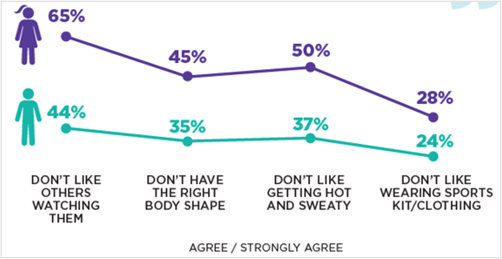
A report from Women in Sport (2021) found significant emotional barriers for all teenagers in taking part, although these were more common for girls. Seven in 10 girls also avoided being active when on their period.
Recent research from Australia shows that having comfortable, well-fitting kit to wear when getting active is crucial for girls. 90% preferred a comfortable t-shirt and shorts in dark colours (Victoria University, 2020). Research such as this has prompted increasing numbers of elite female athletes to speak out about this issues, including pole vaulter Holly Bradshaw criticising skimpy athletics kit, tennis player Monica Puig highlighting the stress of wearing white at Wimbledon when on your period, and numerous female footballers being vocal about their objections to wearing white shorts when playing, leading to many clubs, including West Brom and more recently Man City, ditching white shorts for their women’s teams.
Youth Sport Trust (2022) also found that only 36% teenage girls had a sports bra to take part in PE, even though 49% recognised that it was important for participation, and 46% said it was important for breast health.
Consulting with Young People
Sported’s consultation with young people in Wales (2021) found that young people wanted to be respected and were supportive of more youth consultation. Ideas proposed included more youth leadership and young people working in partnership with teachers, coaches, parents and mentors. The young people also wanted more help to understand how they could influence things that impacted their future, like the environment.
Mental health came through as a major area where young people were trying to support one another, and they would welcome support to do more. Participants were also clear about their frustration when they are asked for their views but then ignored. A small number of young people also expressed a lack of confidence in giving their views, feeling it was easier to go along with everyone else.
The Welsh Enquiry into Physical Activity of Children & Young People (2019) heard evidence that there is a lack of opportunity for girls in particular to engage in a broad range of activities, and that open discussion about what girls want still wasn’t the norm:
“When I talk to girls, they generally say that they tell their teacher that they’d like to play football, say, and they’re told, ‘No, that’s not part of what we offer here. Some [girls] have had success in…saying what they would like, and their teachers have listened, but it’s not really encouraged…to have that kind of open discussion and dialogue about it..”
Insight & Policy Manager, Women in Sport
James et al (2018) discuss how designing interventions with target populations increases their legitimacy, justifiability and feasibility. They result in programmes which are more attuned to users’ needs and can be more effective in achieving their aims.
The young people in this study expressed that they were interested in co-creation and were comfortable to self-organize in informal settings.
5. Young People as Digital Natives
Today’s teenagers are the first to be born into a fully digital world and the expectation to be a connected digital native is high. The internet gives endless access to knowledge, but to potentially harmful influences too. Social media can be a haven, and has been a lifeline for many young people during the pandemic; however, it can also create unrealistic expectations of what young people should look like and what they should be achieving.
A variety of data from the Ofcom Online Nation report (2021) illustrates young people’s digital usage.
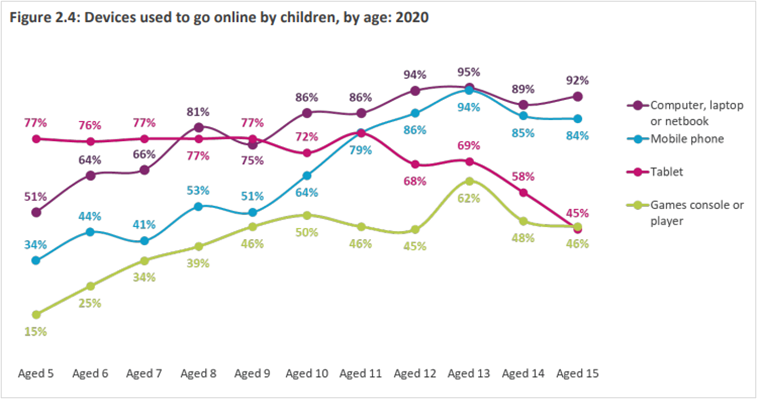
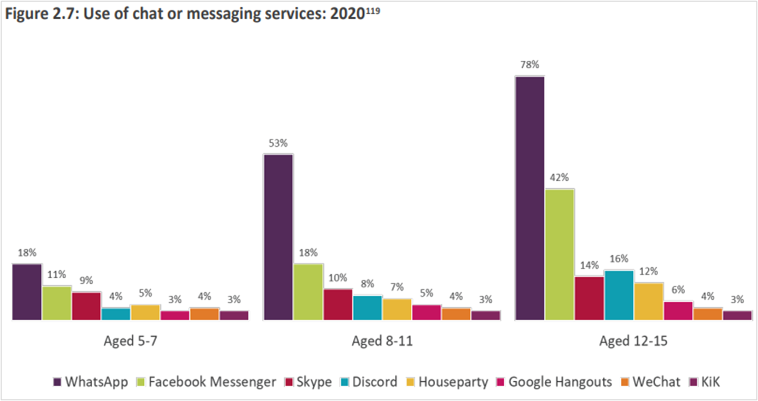
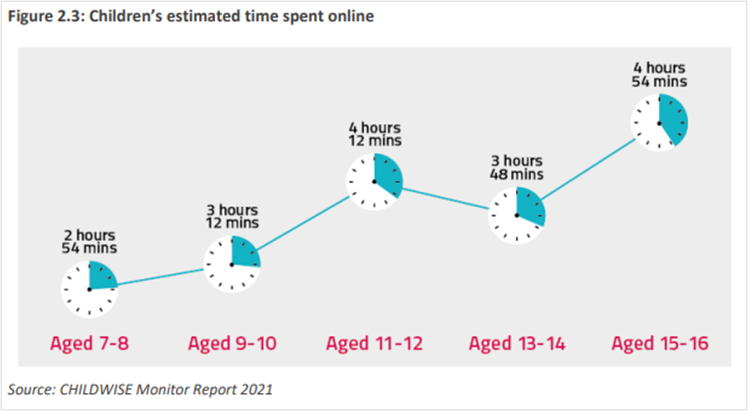
In 2020, 99% of online 12-15-year-olds used social video services. 9 in 10 young people who used social media or chat apps felt pressure to be popular on them.
Further analysis from Ofcom (2022) offered a summary of online behaviours for 12-15 year olds, revealing children were more likely to experience being bullied online than face-to-face: 84% of 8-17 year olds said they had been bullied via text or messaging, on social media, in online games, through phone or video calls, or via other apps and sites, compared to 61% being bullied face-to-face.
In spite of this, 13-17 year olds were more likely to feel positive than negative about their online use: 53% said that being online was good for their mental health, whilst 17% disagreed with this. Eight in 10 children aged 13-17 used online services to find support for their wellbeing.
Women in Sport (2019) discussed how social media influencers have become overwhelmingly popular, having millions of online followers and a huge influence on the aspirations, attitudes and behaviours of teenage girls. Many social media influencers are self-made, everyday people and some are young teenagers themselves, so girls feel able to relate to them, with younger girls in particular being more likely to aspire to be like their favourite Vlogger or YouTuber when they are older. Whilst this can have down sides, it also opens up opportunities to inspire and influence girls to be more active through their online icons.
It is worth noting, however, that in 2021, Mayor Andy Burnham highlighted that there were 100,000 children and young people living in digital poverty in Greater Manchester, prompting a number of initiatives, such as the GM Tech Fund, to be set up to tackle this divide.
6. Impact of the Pandemic and Cost of Living Crisis
A global poll by Ipsos MORI (July 2021) found that 45% Britons predict worse mental health and wellbeing will be one of the longest lasting outcomes of the pandemic for children. This scored higher than catching up on missed education, negative impact on future employability, worse physical health, and underdeveloped social skills.
Sport for development charity, Sported, run a regular Community Pulse Survey with member organisations, who have repeatedly cited young people’s mental health as one of their greatest concerns for their participants. In the last edition (April 2022) 30% raised this as a significant concern with many focusing on young people’s health and wellbeing as a major priority. 22% also raised poverty as a major concern, with almost two-thirds having responded to the cost of living crisis by providing cheaper or free memberships for their members. This is in spite of their own organisational financial concerns, with many groups operating on a shoestring already.
In May 2022, research by Coop found that 47% of children (10-25) were already acutely aware of the rising cost of living, and almost 3 in 10 believe there are no future opportunities for them where they live. 54% think it will be hard for them to save money for their future and 27% felt less hopeful about the future.
Research by Women in Sport (2021) found that the pandemic heavily impacted on teenage girls in a number of ways:
- 70% missed hanging out with friends most during lockdown and many reported feeling less close to their friends.
- 58% said they spent more time with family and that the pandemic brought them closer. In particular girls described their mums as an important source of support.
- 55% said being on social media is fun and relieves boredom, but 39% said too much made them feel anxious.
- 55% reported that it is more difficult to feel positive about life since the pandemic started and many reported feeling bored, lonely or anxious.
Girls in particular have missed out on important opportunities to develop their independence like going to friends’ houses, going shopping, or trips to the cinema. Although as restrictions have lifted it has also made them take-up and appreciate opportunities that they otherwise might not have.
7. Implications for Feel Good Your Way
- Mental health is a major concern for young people at present; this means the campaign in many ways will be pushing at an open door in offering a means to support better mental health. Nonetheless, it needs to offer being active as more than something young people should do if it is to cut through their many influences and priorities.
- Against the complex backdrop of young people’s lives, physical activity is not always a top priority; this becomes increasingly true as young people enter secondary school and the pressures of life increase. The campaign will need to tackle these perceptions head on and create a sense that being active is important and worth young people’s time.
- There is a complex array of social and emotional barriers at play which govern whether teenagers take part. These are particularly pronounced for girls, for LGBTQIA+ young people, and for young people from disadvantaged backgrounds. More opportunities and making it free or cheap will not be enough to tackle these, as discerning teenagers seek to feel welcome, included and engaged.
- We have seen the importance of peer influence, so how both mental health and physical activity are perceived by peers will be important in shaping teenagers’ desire to take part. We will need to bring friendship groups on board, as opposed to asking young people to take the step themselves without any peer support. It is vital, especially for girls, that teenagers can do things with their friends.
- Parental influence does still play a role for our audience, particularly mums, but may not always be the main decision driver.
- Poor body image, peer pressure, and bullying can all be common sources of poor mental health for our target group. They can also be barriers to girls getting active. The campaign will need to tackle these issues sensitively to ensure being active is presented as an accessible and achievable pursuit, and does not inadvertently exacerbate existing anxieties. For example, the kit that any young people are featured in should look relaxed and comfortable, rather than tight or revealing, and the level of difficulty of activities should appear challenging enough to be engaging, but still seem attainable for everyone.
- Having fun is a big priority for young people, especially after the last few years, so the campaign will need to be playful and inviting, but on their terms rather than an adult version of what we think might be fun.
- Technology and online behaviours are also pervasive in young people’s lives and, whilst many recognise the risks that this can present, the majority still see being online as a good thing and something which can support positive mental health, through seeking information and advice or by connecting with friends. The campaign will need to consider how best to align with young people’s existing digital selves.
- Listening to young people’s voices and applying co-creation to the design of activities and interventions still does not appear to be the norm, with young people frequently reporting they do not feel listened to. For this campaign, co-creation remains an essential element.
NB. This insight report was produced by Proper Active as part of the Feel Good Your Way campaign.
8. References
- Activity Alliance (2020) My Active Future – Including Every Child
- BeeWell (2022) BeeWell Survey 2021 Headline Findings
- BeeWell (2022) Evidence Briefing 1: Inequalities in Young People’s Wellbeing
- Centre for Mental Health (2020) COVID and the nations mental health
- Coop (2022) Levelling up: Too little too late? Almost half of 10 -25-year-olds say they need to leave hometown to get on in life - Co-op (co-operative.coop)
- DHSC (2019) UK Chief Medical Officers Physical Activity Guidelines
- Education Policy Institute (2022) Neighbourhood Characteristics and young people's wellbeing in Greater Manchester
- GMPA (2021) Poverty Monitor Poverty Monitor 2022: Child Poverty - Greater Manchester Poverty Action (gmpovertyaction.org). Accessed 28/10/2022.
- Ipsos MORI (2018) Beyond Binary: The lives and choices of Generation Z
- Ipsos MORI (2020) Sexual Orientation & Attitudes to LGBTQ+ in Britain Sexual orientation and attitudes to LGBTQ+ in Britain | Ipsos
- Ipsos MORI (2021) Impact of COVID-19 on children and young people’s education, wellbeing and life opportunities
- Ipsos MORI (2022) Climate literacy amongst school leavers
- James et al. Teenage recommendations to improve physical activity for their age group: a qualitative study. BMC Public Health. 2018, 18, 372.
- Mendolia et al (2022) Have girls been left behind during COVID-19 – gender differences in pandemic effects on mental wellbeing
- MIND (2021) Coronavirus: the consequences of the pandemic for mental health
- MIND (2021) Not making the grade: why our approach to mental health at secondary school is failing young people
- National Assembly HSC and Sport Committee (2019) Enquiry into Physical Activity of Children & Young People
- NHS Digital (2021) Mental Health of Children and Young People 2021
- Ofcom (2021) online-nation-2021-report
- Ofcom (2022) Children and parents media use and attitudes report 2022
- Press Red (2022) National Rise of Girls Activity
- Sported (2021) Young People Consultation Wales
- Sported (2022) Community Pulse Survey
- Sport England (2021) Active Lives Survey. Queries run October 2022. Active Lives | Home (sportengland.org)
- Sport England (2021) TGC Campaign Summary
- Street Games (2016) Exploring Sports Pathways
- Student Minds (2022) Student Mental Health: Life in a Pandemic – Wave 3 findings
- The Children’s Society (2022) The Good Childhood Report
- Victoria University (2020) What girls want in sport uniforms to make them feel comfortable and confident to participate in sport
- WIS (2019) Reframing Sport for Teenage Girls: Building Strong Foundations for their Futures
- WIS (2021) The impact of Covid-19 on Teenage Girls Lives and Physical Activity
- YST (2021) The Class of 2035 – How sport can empower a generation to build a brighter tomorrow
- YST (2022) Girls Active – National Report for Girls Data
